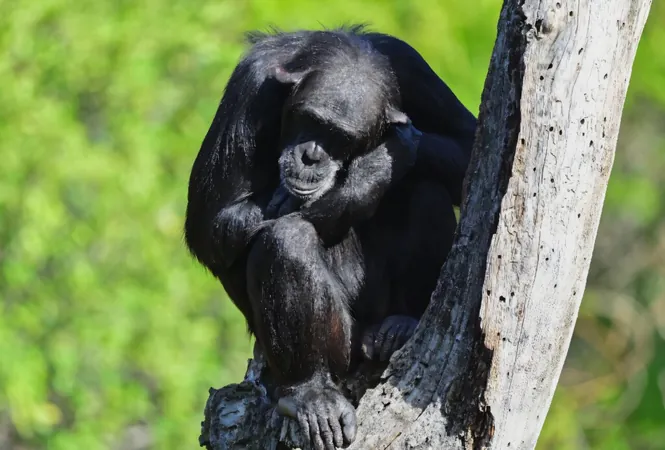
Chimps Show Surprising Advances in Tool Use: A Groundbreaking Study Reveals!
2024-11-24
Author: Wei Ling
Introduction
In a remarkable turn of events that echoes the wisdom of the fictional "Planet of the Apes," recent research indicates that chimpanzees are refining their tool-using abilities at a pace that challenges long-held beliefs. Through a comprehensive study published in the esteemed journal Science, scientists reveal that these intelligent primates have been sharpening their skills over thousands of years, driven by the exchange of ideas fostered by migrations between different populations.
Study Overview
The study, led by Cassandra Gunasekaram, a promising doctoral student at the University of Zurich, not only highlights the incredible adaptability of chimpanzees—humans' closest living relatives—but also draws intriguing parallels to human technological advancements. Gunasekaram noted that our own ancestral roots likely leveraged social connections and interaction to enhance their tool-making capabilities.
Cultural Transmission in Chimpanzees
Historically, researchers have admired chimpanzees' remarkable ability to pass down complex behaviors, such as tool use, from one generation to the next. While human civilizations have undergone immense transformations—from the Stone Age to the Space Age—chimpanzee "culture" has appeared static. However, Gunasekaram set out to test this notion, and the findings are nothing short of revolutionary.
Migration Sparks Innovation
Combining ancient migratory data with observations of 15 distinct foraging techniques across various chimp populations and subspecies, the researchers categorized these behaviors into three groups: those requiring no tools, simple tool usage (like using chewed leaves as sponges to collect water), and advanced toolsets.
One fascinating example emerged from the Congo, where chimpanzees utilize sturdy sticks to bore into the earth and reach termite nests. They even modify plant stems into brushes to fish for termites in the tunnels they've created. This sophisticated behavior was found to be closely linked to populations that formed connections through genetic exchanges over 5,000 to 15,000 years ago, emphasizing how cultural knowledge transfers between groups can spark innovation.
The most elaborate instances of tool use were recorded in areas where three subspecies intermingle, underscoring the importance of inter-group connections in advancing cultural practices. Conversely, simpler behaviors, such as foraging without tools, seemed to develop independently, showcasing the varied paths of evolution within different environments.
Learning from Each Other: The Essence of Foraging
Gunasekaram likened this phenomenon to the way human societies have advanced through idea exchanges, moving from early computational devices to the cutting-edge technology we have today. "The complexity of chimpanzee tool use has evolved to the point where no single individual could recreate these techniques without prior knowledge," she explained.
Unlike humans, however, chimps face limitations in their interactions, as migrations are gradual processes largely prompted by the need to avoid inbreeding. This slow-paced movement of sexually mature females into new communities restricts their exposure to novel ideas and individuals.
Challenges in Studying Chimpanzee Culture
To tackle the challenge of studying chimpanzee culture—which has only been subjected to scientific scrutiny for about a century—the research team utilized genetic data from ancient migrations. The ephemeral nature of chimpanzee tools, often made from perishable materials like sticks and plant stems, further complicates efforts to trace their developmental history.
Future of Chimpanzee Tool Use
So, is it possible for chimpanzees to reach a level of ingenuity comparable to that of humans? While unlikely, the study suggests that with time, they could become more adept at foraging. Some populations are already excelling in nut-cracking techniques, using hammers and anvils crafted from stone. One particularly innovative group has even created a stabilizer for their anvils!
As we continue to observe and understand the cognitive advancements of our primate cousins, the question remains: how far can their tools evolve? The journey of discovery is just beginning!



 Brasil (PT)
Brasil (PT)
 Canada (EN)
Canada (EN)
 Chile (ES)
Chile (ES)
 España (ES)
España (ES)
 France (FR)
France (FR)
 Hong Kong (EN)
Hong Kong (EN)
 Italia (IT)
Italia (IT)
 日本 (JA)
日本 (JA)
 Magyarország (HU)
Magyarország (HU)
 Norge (NO)
Norge (NO)
 Polska (PL)
Polska (PL)
 Schweiz (DE)
Schweiz (DE)
 Singapore (EN)
Singapore (EN)
 Sverige (SV)
Sverige (SV)
 Suomi (FI)
Suomi (FI)
 Türkiye (TR)
Türkiye (TR)